Understanding the intricacies of chord progressions is a pivotal aspect for music producers, composers, and enthusiasts alike.
These progressions serve as the backbone of many tracks, providing the fundamental harmonic structure upon which melodies and rhythms are built.
Creating atmospheric compositions calls for in-depth knowledge of ambient chord progressions.
This knowledge helps to evoke the desired moods and emotions in listeners.
In the realm of atmospheric music, the chords you choose can indeed make or break the ambiance of the track.
Thus, an overview of ambient chord progressions is necessary for those seeking to master this genre.
Table of Contents
- Ambient Chord Progressions
- I-IV-V (1-4-5)
- ii-V-I (2-5-1)
- IV-vi-V (4-6-5)
- vii°-IV-I (7-4-1)
- ii-vi-IV (2-6-4)
- V-ii-V (5-2-5)
- I-IV-ii-V (1-4-2-5)
- vi-ii-IV-V (6-2-4-5)
- iv-I-vi-V (4-1-6-5)
- vii°-I-vi-IV (7-1-6-4)
- ii-vi-vii°-I (2-6-7-1)
- iv-vii-ii-V (4-7-2-5)
- vi-IV-I-V (6-4-1-5)
- IV-vii°-vi-I (4-7-6-1)
- V-IV-ii-vi (5-4-2-6)
- I-vi-IV-V (1-6-4-5)
- ii-V-I-IV (2-5-1-4)
- The Bottom Line
Ambient Chord Progressions
I-IV-V (1-4-5)
The I-IV-V progression offers a warm, uplifting mood perfect for ambient atmospheres.
The I-IV-V chord progression is a fundamental sequence in music, especially prominent in genres like blues, pop, and rock. Its simplicity lends itself perfectly to crafting ambient tracks, providing a harmonious base that can evoke a sense of tranquility and evocative atmosphere when coupled with suitable instruments and sound design.
- Difficulty: Easy
- Example: G – C – D (Key of G major)
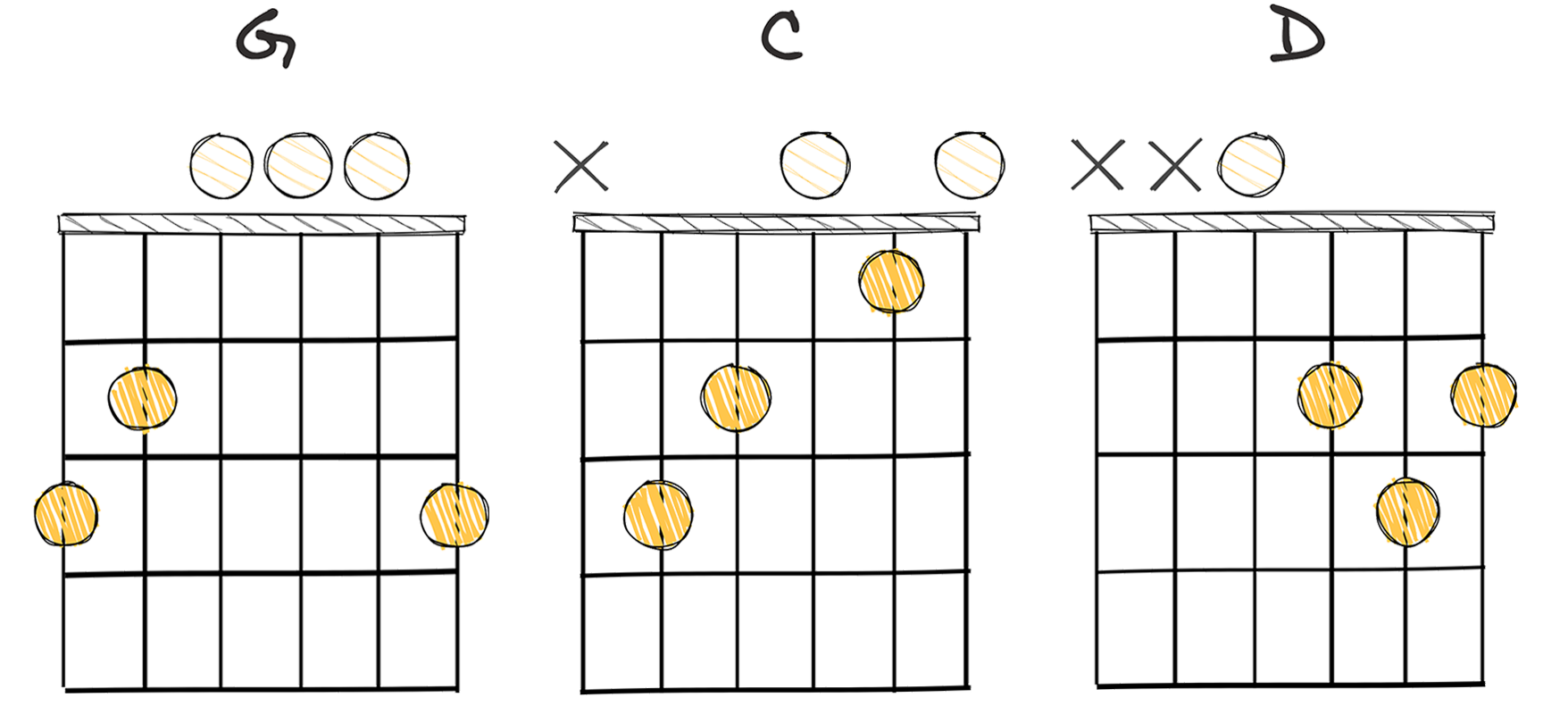
The I-IV-V (1-4-5) chord progression is one of the most widely used sequences in music.
This progression, commonly found in blues and country music genres, creates a sublime atmosphere, bringing a unique warmth and nostalgia.
The historical roots of this popular progression can be traced back to classical music and traditional folk songs.
Its simplicity makes the I-IV-V progression a favourite among beginner musicians, and its flexibility lends itself well to the ambient genre of music, where atmospheric soundscapes are preeminent.
This quote highlights the versatility of the 1-4-5 chord progression.
It’s simplicity and flexibility makes it an essential tool in songwriting, particularly useful for creating atmospheric soundscapes in ambient music.
The I-IV-V progression is known for being easy to play, making it accessible to musicians of all levels.
Despite the apparent simplicity of this three-chord progression, it is capable of creating a diverse array of moods and emotions, owing to the infinite possibilities of musical interpretation.
The familiarities of the I-IV-V also make it ideal for creating melodic hooks and instantly recognisable tunes.
Furthermore, the use of this progression in ambient music often contributes to a harmonic and balanced sound, largely due to the perfect cadence created between the V and I chords.
Playing with the rhythm and articulation of the chords in this progression can also contribute to the atmospheric soundscape in an ambient piece.
When used subtly with creative sound design techniques, the I-IV-V chord progression can play a vital role in constructing the immersive sonic environments found in atmospheric music.
Interestingly, this progression’s natural resolution from tension to release (created by the movement from the V chord to the I chord) can evoke a sense of peace and tranquillity—qualities often associated with ambient music.
Much like other aspects of composing, understanding and utilising the I-IV-V chord progression is part art, part science.
It is about striking the right balance between respecting musical theory and rules while also injecting personal creativity into the music.
ii-V-I (2-5-1)
The backbone of enchanting, ethereal ambiance in music.
The ii-V-I (2-5-1) progression is a classic harmonic pattern widely used in various genres of music, specifically jazz and pop. It is crucial for creating melodious and atmospheric music as it offers a sense of resolution and tranquility, ensuring smooth transitions between chords.
- Difficulty: Intermediate
- Example: Dm – G – C (Key of C major)
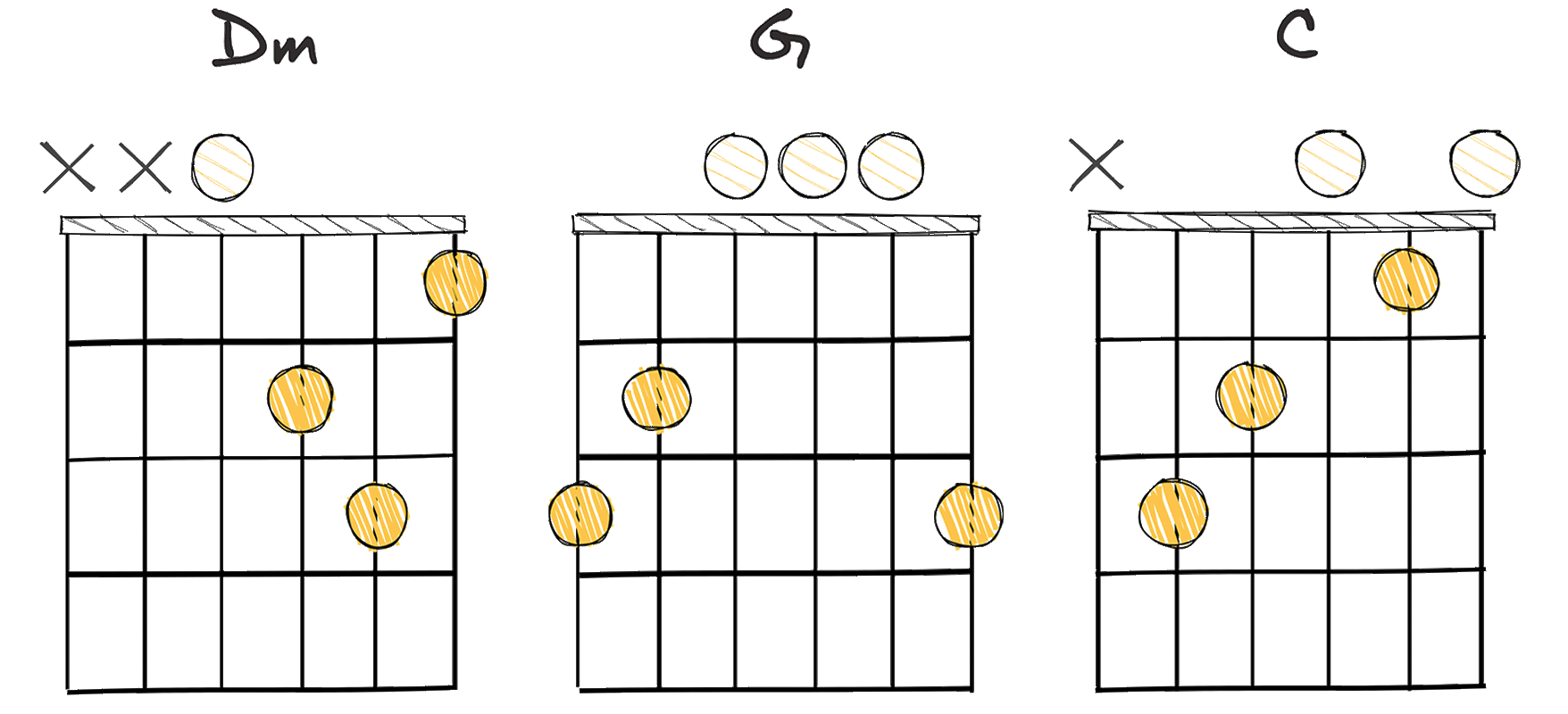
The ii-V-I (2-5-1) chord progression, pronounced as ‘two-five-one’, is fundamental to many music genres, including ambient music.
This elegant progression has its roots in classical music, dating back centuries, but has been adapted over time to accommodate various genres, each adding its unique twist.
The ii-V-I progression in key C major follows the pattern Dm – G – C, where D minor (ii) is the subdominant minor, G (V) is the dominant, and C (I) is the tonic.
One of the major reasons for its popularity in ambient and atmospheric music is its inherent sense of resolution, a seamless transition from tension to release that lends itself to a soothing, ethereal sonic landscape.
The chord progression is amicable to the ear, provides smooth transitions and ends on a resolving note.
These aspects make it a perfect tool for ambient compositions.
The quoted point emphasizes the suitability of the ii-V-I progression for creating atmospheric music.
This progression’s tension and release mechanism lends itself beautifully to painting serene musical landscapes.
Moreover, its versatility in accommodating various chord substitutions and extensions can give the ambient composition depth, complexity, and richness.
While the progression is not particularly challenging to play, it assumes an intermediate level of chord construction understanding and application.
Most notably, musicians need to be able to identify the ii, V, and I chords within a key, move between these chords smoothly, and incorporate them into a larger composition.
One interesting point to note about the ii-V-I progression, particularly in the context of ambient music, is how it can create a sense of movement and direction without relying on the strong, dramatic changes associated with other progression types.
This allows ambient composers to concentrate on creating ethereal, spacious soundscapes where the main focus of the piece is the texture and atmospheric quality.
For budding ambient composers, the ii-V-I chord progression serves as a great starting point for creating atmospheric pieces — it’s a tool that provides familiarity, versatility, and an expressively wide range that complements the genre’s essence perfectly.
All these factors collectively lay the foundation of a progression that has resilience, adaptability and expansive feel, all quintessential to creating ambient music.
IV-vi-V (4-6-5)
This progression offers a dreamy, atmospheric sound perfect for ambient music.
The IV-vi-V chord progression in music is renowned for evoking a deeply ambient and atmospheric sound, effortlessly creating a peaceful, serene, and tranquil sonic space. Perfect for creating a dreamy soundscape, this progression smoothly transitions from the subdominant to the relative minor, before resolving back to the dominant chord, providing a soothing yet stirring musical journey.
- Difficulty: Easy
- Example: Bb – Dm – C (Key of F major)
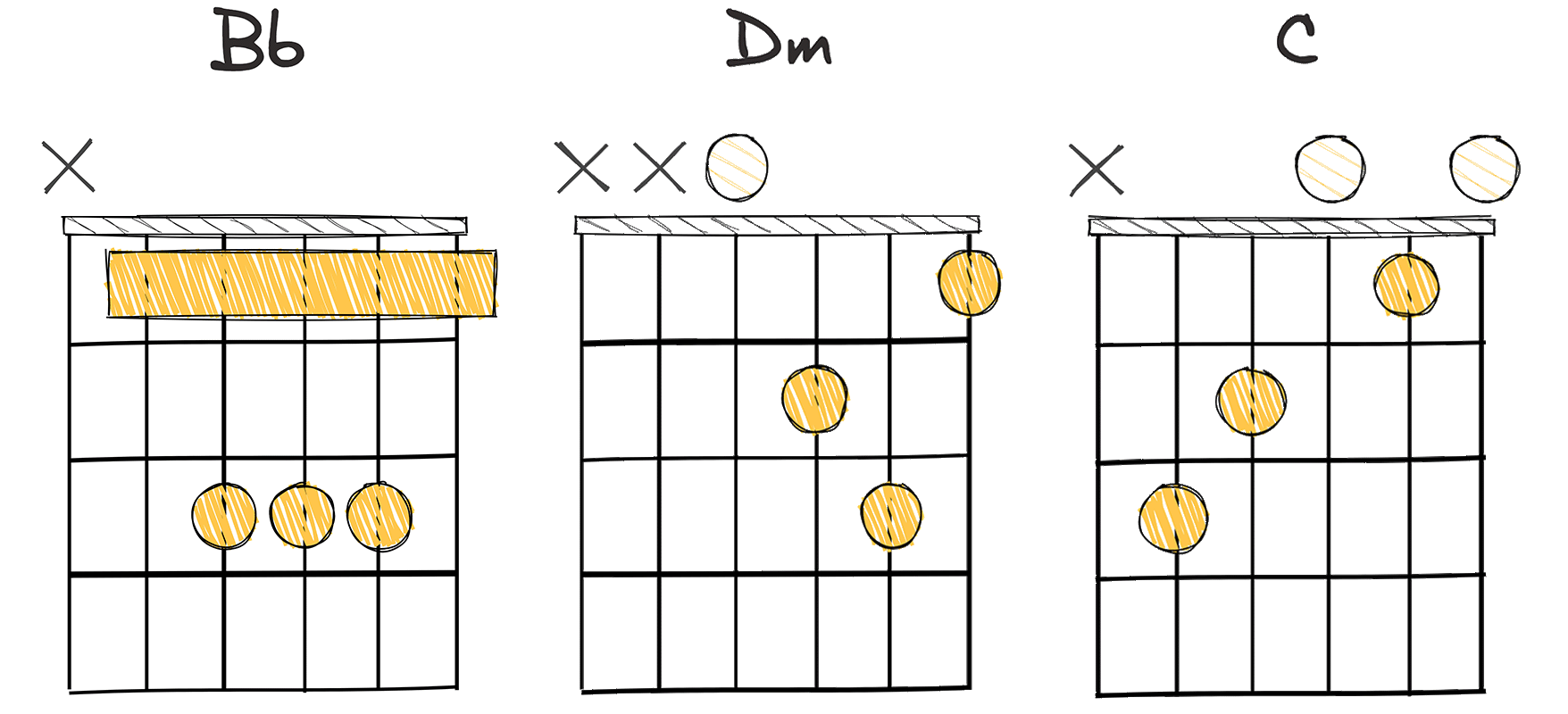
The IV-vi-V chord progression, represented numerically as 4-6-5, is a common sequence of chords in the music world, particularly in ambient and atmospheric genres.
Using the Roman numeral system, this progression corresponds to the fourth, sixth, and fifth chords of a given key.
In the key of F major, for instance, these chords would be Bb – Dm – C.
Although simple at its core, the IV-vi-V progression possesses a unique trait that allows for extensive creativity – it manages to be both predictable and surprising.
Because the IV and V chords are often used in conjunction, the surprise of the vi chord between them creates an unanticipated tension, which can lend a hauntingly beautiful quality to a piece.
Backing up this idea, countless compositions in the realm of ambient and atmospheric music utilize this element of surprise to evoke particular emotions or create certain moods within their soundscapes.
The power of the IV-vi-V progression is not only demonstrated in its function within a piece but also in its historical use.
As far back as the Baroque era, composers have been using this progression to lay a soothing foundation for their melodies, with each chord providing a different shade of harmony for the melody to interact with.
Even current musicians continue to apply this progression due to its ease of playing and the evocative atmospheres it can create.
Whether you’re an experienced musician or a novice, the IV-vi-V progression offers an accessible technique to start creating your own ambient pieces.
Remember, by understanding the mechanics behind why certain chord progressions, such as IV-vi-V, work, you can experiment and innovate in your music-making process.
vii°-IV-I (7-4-1)
A tension-filled progression perfect for crafting dreamy atmospheres.
The vii°-IV-I chord progression, characterized by its mellow transition from a leading-tone seventh chord to the subdominant fourth, ending on the tonic, provides a smooth, flowing foundation perfect for producing ethereal music. The unique movement of this progression offers nuanced harmonics, promoting an overall soundscape that’s ambient and mood-enhancing, perfect for crafting atmospheric and immersive musical experiences.
- Difficulty: Intermediate
- Example: A#dim – E – B (Key of B major)
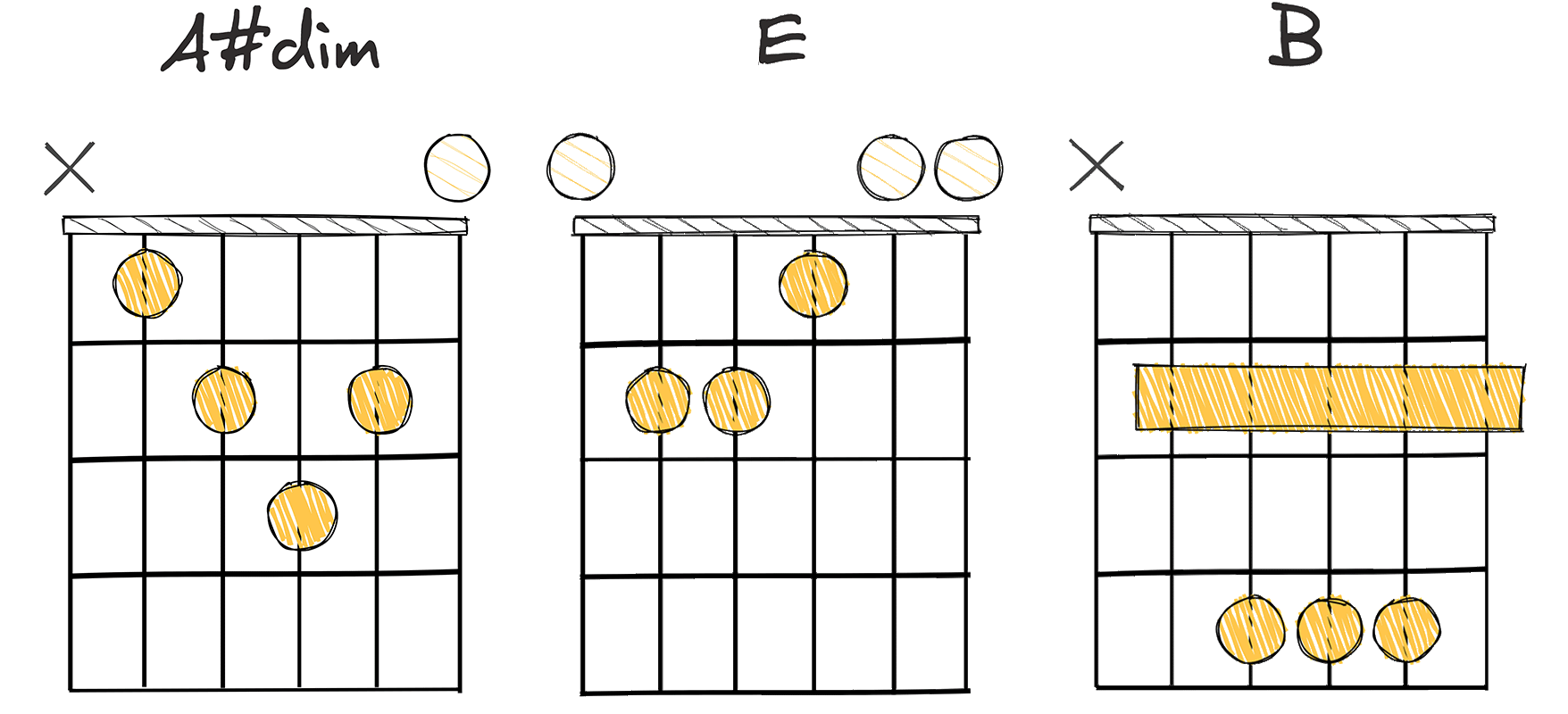
The chord progression vii°-IV-I exhibits a profound harmony, generally utilized in crafting the stunningly diverse world of ambient music.
Known for its ability to transition effectively between moods and sentiments, this chord progression has been the go-to template for several artists over the years.
Seeing its rise to prominence around the mid-20th century, vii°-IV-I has played a vital role in the evolution of ambient music, marking an intermediate level progression in musical compositions.
While this progression might appear to be a tad challenging for beginner musicians due to certain intricate transitions, it tends to offer a uniquely rewarding experience to those having moderate proficiency with chords.
Consider the key of B Major, the chords employing this progression would be A#dim – E – B, a melody that’s enchanting yet simple.
This example serves to highlight the powerful atmospheric tone this progression is capable of crafting.
Building an atmosphere in a composition is no small feat.
However, the use of it in ambient genres not only enriches the overall track but also heightens the emotive resonance.
Thus the artist can create a wide variety of moods, ranging from meditative tranquility to brooding melancholy, showcasing the versatility of the vii°-IV-I progression.
The trick with this progression is in understanding the sequential movement, wherein the chords weave an intricate dance of tones and intervals, leading to the formation of a beautifully atmospheric melody.
Consistent practice and a sound understanding of chord structures can aid any aspiring artist to master this progression.
Moreover, its effectiveness lies in its simplicity and fortitude, making it a staple amongst ambient music producers around the globe.
It is as if the progression is a canvas that allows a musician to paint any mood they wish to communicate.
Ambient music, replete with its visceral sensuality and ethereal resonance, finds a faithful ally in the vii°-IV-I progression, reaching untapped depths of human emotionality.
By creating a profound harmonic resonance, it imbues the composition with a certain depth.
Moving forward, the nuances of this melodic progression would continue to contribute significantly to the genre of ambient music, propelling it towards further avenues for creative expression.
ii-vi-IV (2-6-4)
A minor-centered progression invoking a peaceful, dreamy soundscape.
The ii-vi-IV (2-6-4) chord progression offers a layered, complex sound with a soothing depth perfect for creating ambient or atmospheric music. This progression creates its unique sound by shifting from minor chords to a major chord, contributing to an overall feeling of depth, tranquility, and introspection in the composition.
- Difficulty: Easy
- Example: Em – Bm – G (Key of D major)
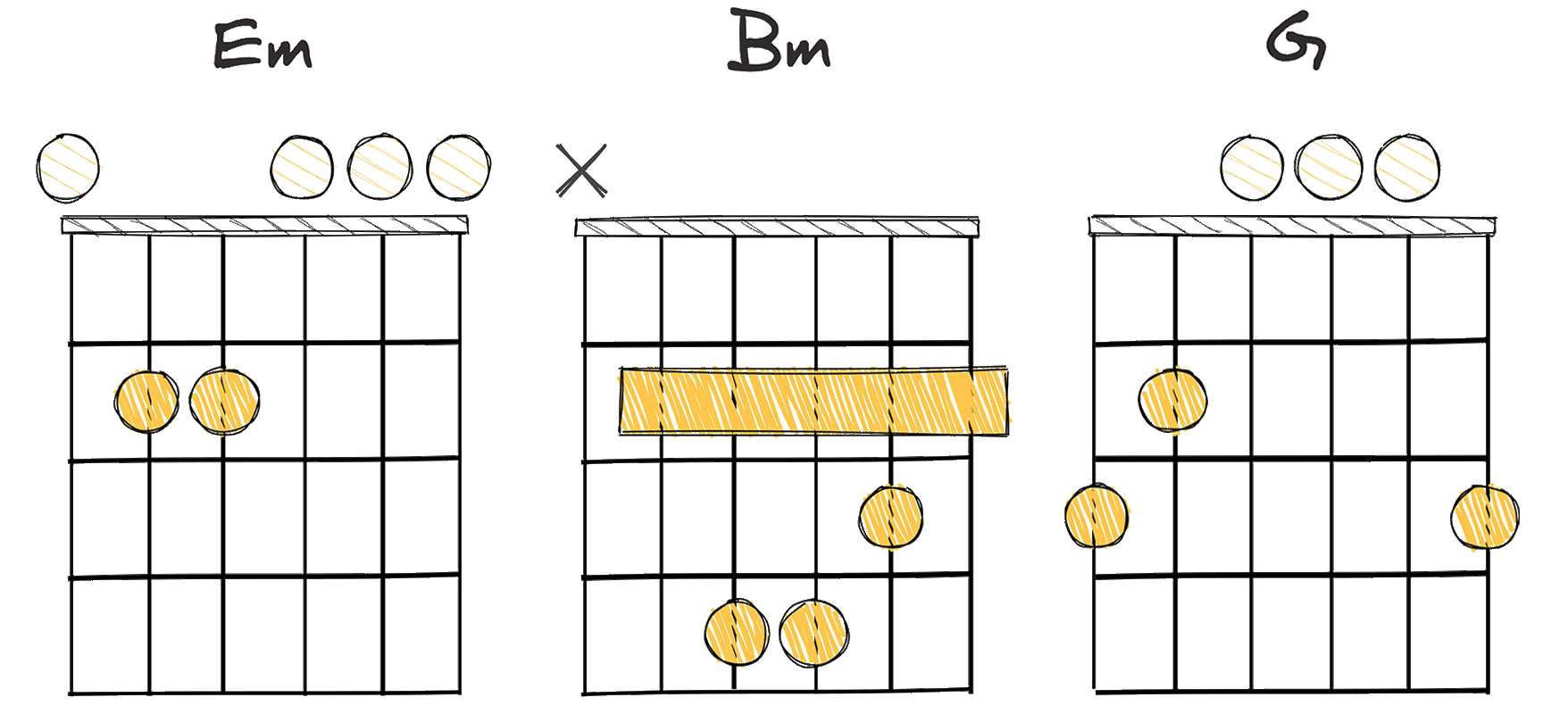
The ii-vi-IV chord progression, commonly referred to as the 2-6-4 progression, has been widely used in a variety of musical genres, but it is particularly effective in ambient music, a style known for its focus on creating atmospheric soundscapes.
The genesis of the 2-6-4 progression can be traced back to the classical era, but it gained popularity in the modern era through its usage in pop and rock music before being adopted into the ambient genre.
While it can be said that many chord progressions are easy to play, the 2-6-4 often stands out for its comfortably flowing patterns on the keyboard or guitar fretboard.
This easy playability contributes significantly to its popularity among ambient musicians, particularly those who are relatively new to chord progressions and are dabbling in the creation of atmospheric soundscapes.
Therefore, the ease of playing this progression, combined with the distinct harmonic character it brings, makes it a beloved choice for creating that compelling ambient musical atmosphere.
The transitions between the chords create an intriguing sonic narrative that enhances the ambient atmosphere of a piece of music.
Not only can it be looped to create a hypnotic aural texture, but it can also be embellished with extended chords, volume and tone modulations, and various sound design tactics to add depth and richness to the music.
Ambient musicians like Brian Eno and Jon Hopkins have used this progression effectively in their compositions to craft soundscapes that are intricate, rich, and, most importantly, highly evocative.
The ii-vi-IV chord progression, or the 2-6-4 progression, has proven itself to be a powerful tool in the creation of atmospheric music, regardless of genre.
Its easy playability, captivating harmonic character, and endless potential for modification make it a must-know progression for any musician looking to delve into the world of ambient music.
V-ii-V (5-2-5)
A subtle ebb and flow that breathes life into ambient compositions.
The V-ii-V chord progression is a sequence commonly utilized in ambient music to create a melancholic or contemplative mood. The fifth, second, and again the fifth degree, described in this progression, conveys an atmospheric, ethereal tone, making it an excellent choice for composers looking to evoke a sense of calm and tranquility in their compositions.
- Difficulty: Intermediate
- Example: D – Am – D (Key of G major)
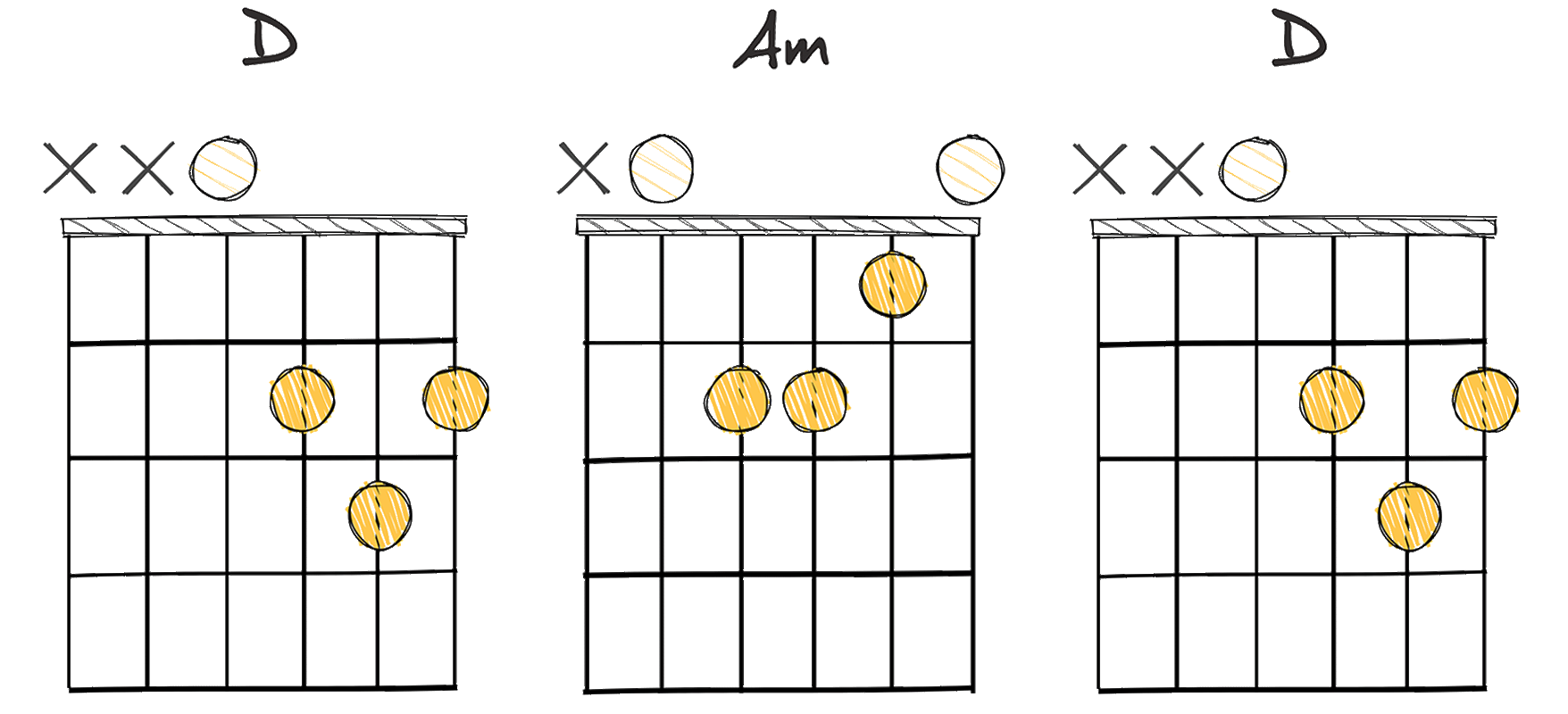
The V-ii-V (5-2-5) is a chord progression that offers exceptional potential for those interested in creating atmospheric music.
Typically found within a major key, this progression creates an emotive and bittersweet tone that can be exceptionally evocative.
Each of these chords, the fifth (V), the second (ii), and again the fifth (V) lend themselves very well to creating ambient soundscapes.
Take the key of G major for instance, which would entail using the chords D – Am – D.
The fifth chord in G major is D, the second chord is Am, and we return to the fifth chord D to complete the progression.
The sequence of these chords, notably the leap from the dominant fifth ‘D’ back to the subdominant ‘Am’, creates a satisfying tension and release dynamic.
This tension gives invokes an atmospheric feel that is perfect for setting a particular mood or tone.
It’s the primary reason why so many composers and musicians routinely use this progression for background and ambient music.
As a composer, you can experiment with this model by adjusting the rhythm and voicing, to add depth and complexity to your chords.
Despite its widespread use, the V-ii-V progression is considered to be of intermediate difficulty to play.
But like all things in music, a little dedicated practice goes a long way in mastering this progression.
You can find excellent examples of the V-ii-V progression in many songs.
Understanding the history and application of the V-ii-V progression provides a significant edge in constructing your unique ambient soundscape.
Keep in mind that while the V-ii-V progression can aid in creating atmospheric vibes, the real magic lies in how you use it in conjunction with other musical elements.
I-IV-ii-V (1-4-2-5)
This progression infuses ethereal tranquility into ambient soundscapes.
The I-IV-ii-V chord progression is a common harmonic pattern in music that produces a smooth, flowing sound, often used in creating a relaxed, ambient mood. By progressing from the tonic (I), to the subdominant (IV), then touching the supertonic (ii), and finally landing on the dominant (V), this pattern can evoke a sense of serenity and tranquility in atmospheric compositions.
- Difficulty: Moderate
- Example: D – G – Em – A (Key of D major)
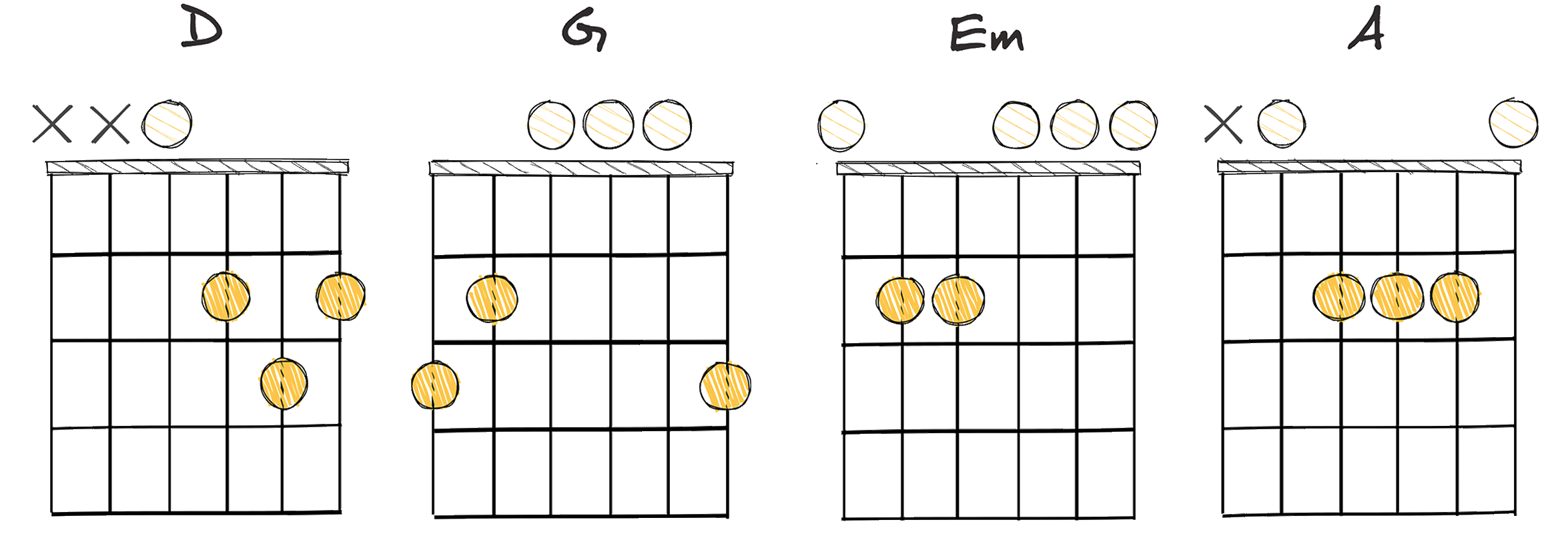
The chord progression I-IV-ii-V (1-4-2-5), also identified in this case as the D-G-Em-A progression in the key of D major, is beneficial for creating ambient and atmospheric music.
These types of chord sequences are often used because they promote emotion and a sense of flowing, ethereal soundscapes that are essential to creating an ambient mood.
The Ambient genre itself favors chord combinations that evoke deep emotions and create the illusion of floating in space or time.
In the history of music, the chord progression I-IV-ii-V has been utilized frequently due to its appealing auditory progression and moderate difficulty level.
As a chord progression, I-IV-ii-V stands out as a popular choice, especially for Ambient music, due to its ability to promote relaxing and contemplative atmospheres.
This progression is inherently soothing, given its harmonious yet continuously moving nature.
Moreover, once familiar with the progression, the moderate difficulty level does not pose a significant challenge to even less experienced musicians.
Additionally, the I-IV-ii-V progression supports the signature ‘circular movement’ commonly found in many Ambient pieces.
That is, the progression involves a repeating cycle of chords that helps to create a sense of continuous motion, ideal for inducing a contemplative or meditative state in the listener.
Furthermore, this progression can accommodate various modification and substitution strategies to increase its complexity or alter its sound dramatically, offering extensive creative flexibility for composers.
The use of the I-IV-ii-V progression is an effective technique for producing ambient and atmospheric music.
It provides a relaxing, harmonious sound while also possessing the ability to stimulate emotional depth through its inherent circular movement.
Despite not being overly complex, the I-IV-ii-V progression remains a common choice for musicians across various genres, particularly within the realm of Ambient music.
vi-ii-IV-V (6-2-4-5)
An evocative progression lending a dreamy, suspended feel to tracks.
The vi-ii-IV-V chord progression presents a very soothing and ambient vibe, perfect for providing an atmospheric framework to a musical piece. It begins on a minor chord which provides subtle melancholy, then transitions towards more uplifting major chords, maintaining the listener’s interest with contrasting moods and creating a rich, immersive soundscape.
- Difficulty: Intermediate
- Example: Am – Dm – F – G (Key of C major)
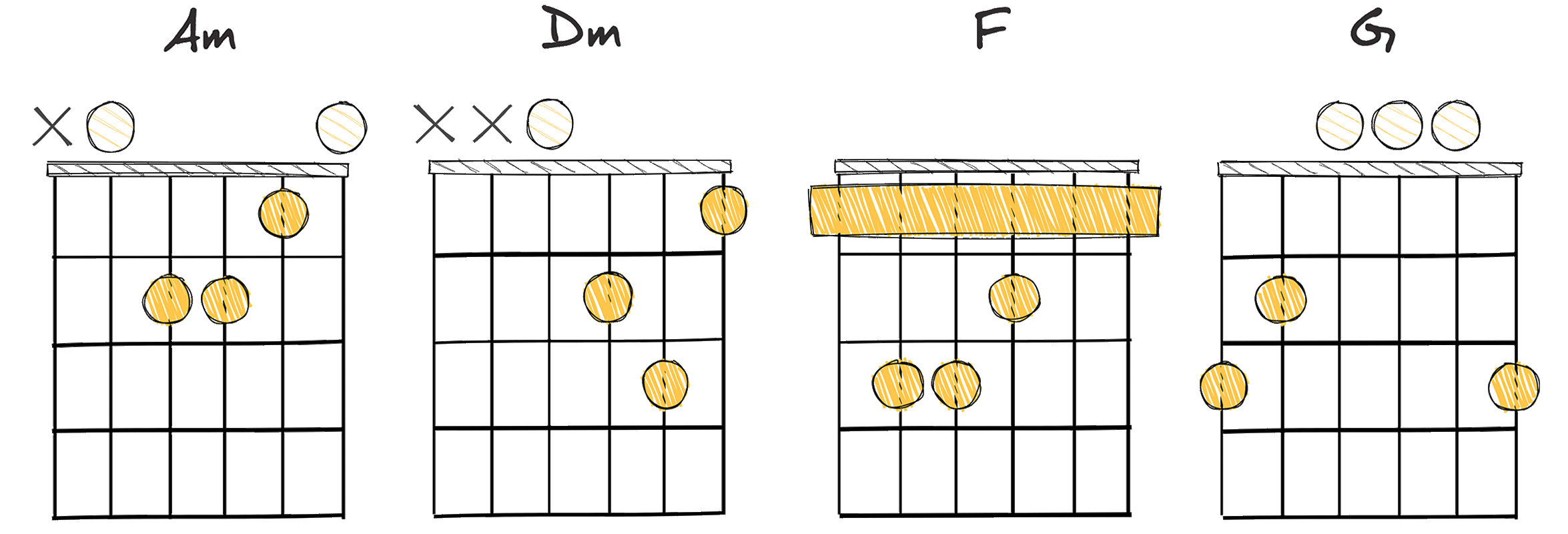
Ambient music often thrives on atmospheric sounds and rich textures, different from other genres which may focus more on rhythm or harmony.
The vi-ii-IV-V (6-2-4-5) progression in ambient music is a well-known sequence that boasts of emotional depth, a feature often sought after in ambient composition.
This progression is not uncommon in cinematic scores, a genre that utilizes ambient elements to drive emotion and evoke feeling.
It starts with a minor chord and transitions into all major chords, promoting an expressive lyrical narrative that ambient music thrives upon.
It stands out because of this unique progression, intricately combining tension and release, inherent in the chords’ progression.
This balance helps to create a rich and hypnotic atmosphere that is characteristic of ambient soundscapes.
The 6-2-4-5 progression has been found in a variety of tracks and over time became a staple in establishing deep atmospheric vibes in ambient music.
Historically, the use of this progression can be traced back to the tonality shift from classical to modern music.
This progression was seen as a way to break the mold of traditional chord structures, unleashing a spectrum of deeper emotions that earlier music did not fully exploit.
Its flexibility in creating different feelings – from hopeful to melancholic – allowed for ambient artists to express their artistic intent more precisely and vividly.
This unexpected movement in chords matched well with the unpredictable and evolving nature of ambient music.
It allows for a more dynamic exploration of sound design and more meaningful emotional connection with the listener.
While the journey of this progression throughout the course of ambient music is significant, its future and potential in the genre seem just as fascinating.
iv-I-vi-V (4-1-6-5)
This progression offers an intriguingly mellow backbone for ambient melodies.
The iv-I-vi-V chord progression is widely used in ambient music for its ability to create a rich yet soothing soundscape that is ideal for atmospheric compositions. Characterized by its deep restoration of the tonic (I) after the subdominant (iv), followed by the relative minor (vi), and finally the dominant (V), it guides the listener through a pleasant, immersive harmonic journey.
- Difficulty: Intermediate
- Example: Ebm – Bb – Gm – F (Key of Bb major)
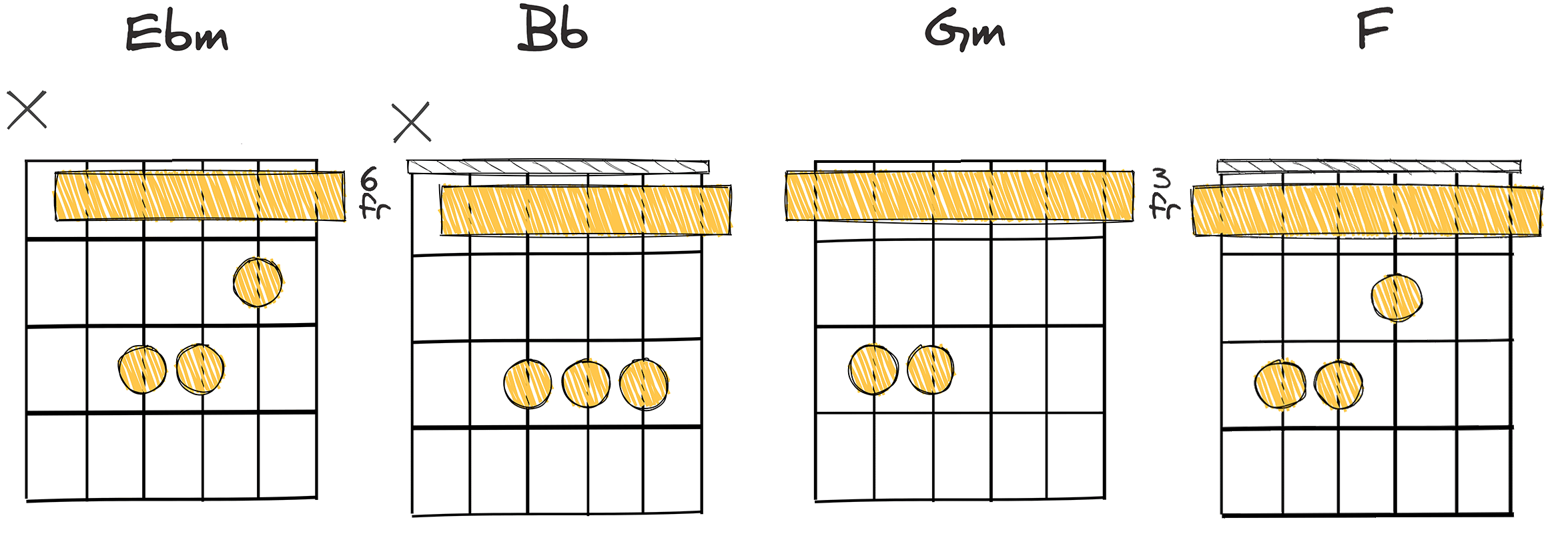
The iv-I-vi-V chord progression, also known as the 4-1-6-5 progression, is a popular sequence included in many types of music genres, but it takes on a unique flavor when used in the realm of ambient music.
This chord progression is relatively intermediate but once mastered, provides a beautiful atmospheric sound that perfectly sets the mood.
One important aspect about this chord progression is that the transition from I to vi is often delayed, adding an element of suspense and anticipation, crucial in creating an ambient atmosphere.
The switch to vi often serves as the “turning point” within the progression leading to a satisfying closure with the V chord.
This is especially true in the context of ambient music where the focus is to create an immersive atmospheric soundscape.
Indeed, the delayed transition to VI, following the I chord, often creates a musical tension that is then released when we finally move to the VI chord.
This manipulation of tension and release is a common technique in music, and works wonderfully to evoke emotions in the world of ambient music.
The 4-1-6-5 progression seems simple, consisting of only four chords, but the mood it sets can be deeply complex and emotionally rich.
Historically, this chord progression has been used in countless songs across many different genres, from pop to rock, classical, blues, and of course, ambient music.
Despite being popular in pop music as well, the iv-I-VI-V chord progression takes on an enchantingly eerie and otherworldly feel when used in ambient music.
When writing an ambient piece, the way these chords are played can as well add to the atmospheric feel of the music.
For instance, using extended voicings, inversions, or adding elements like reverb and delay in the execution of these chords can also elevate the soundscape to a whole new level factor in music production.
Deciding on the right chord progression is a crucial step in creating an ambient piece, but it does not end there.
How one executes those chords is equally important to effectively convey the intended emotions and atmosphere.
The iv-I-vi-V progression is just one of the many chord sequences that can serve as a foundation for ambient music, tapping into the power of harmony to transport listeners into a certain mood or state.
vii°-I-vi-IV (7-1-6-4)
A hauntingly ethereal progression perfect for crafting ambient soundscapes.
The vii-I-vi-IV progression is a commonly used chord sequence in ambient music due to its cyclical nature, lending itself well to atmospheric, fluid compositions. It starts with a tension-filled diminished chord, resolves to a satisfying major, ebbs back to a minor, and then ends with a stabilization on a major chord, offering a balanced blend of both resolve and lingering tension.
- Difficulty: Intermediate
- Example: D#dim – E – C#m – A (Key of E major)
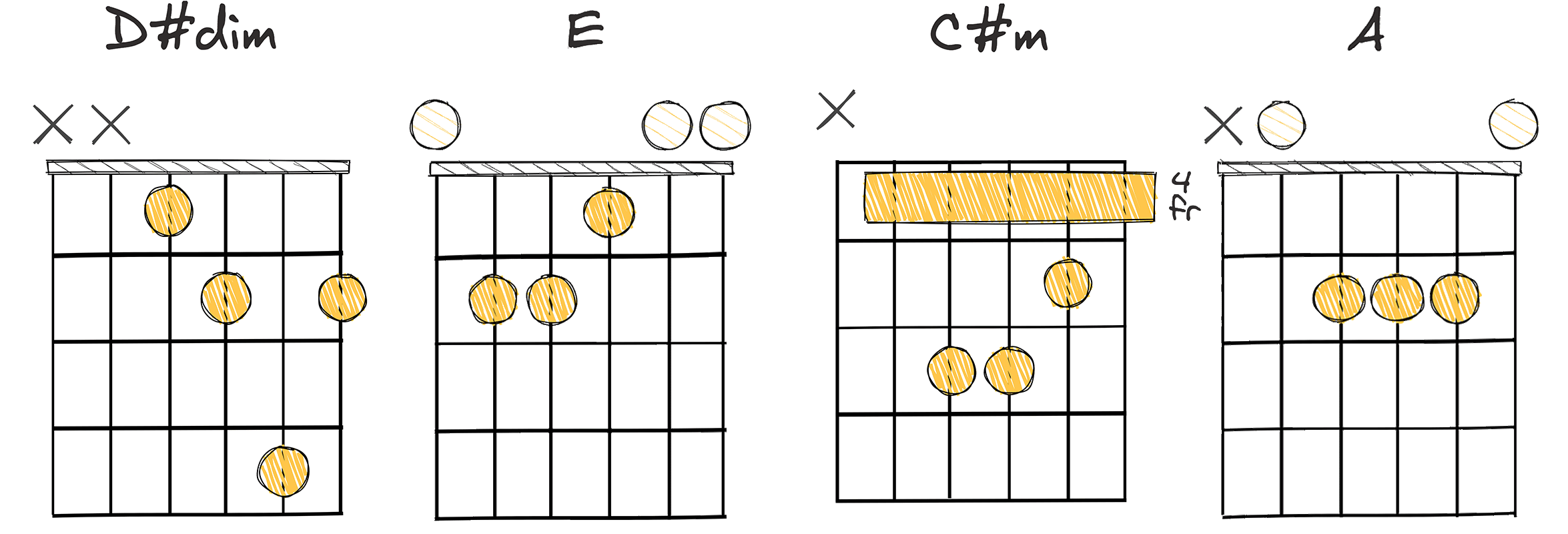
Creating ambient music can be brought to a new level with the use of chord progressions such as vii°-I-vi-IV (7-1-6-4).
This progression creates a particular atmosphere that is often associated with dreamy, relaxing, and soothing music.
The D#dim – E – C#m – A chord progression in the E major scale is an example of this progression, which provides the perfect platform to create a relaxing and atmospheric piece of music.
The beauty of this progression is that it can be manipulated to suit various music styles – From pop, rock, and jazz to even ambient and atmospheric music.
The 7-1-6-4 progression provides a soothing transition between chords whilst creating an engaging and melodic line for the listener.
It offers a sense of completeness when it cycles from the seventh chord (vii) back to the vii, because it moves across the entire tonal range of the scale.
It also gives the listener a sense of expectation – When the progression resolves from the tension-loaded vii to the home chord of I, it creates a satisfying resolution for the listener’s ear.
Historically, the 7-1-6-4 progression has been widely used in many classical pieces as an engine of change and direction within a musical piece.
Moreover, the progression is not solely confined to classical music, but it has found its place in many popular tracks in modern times.
In terms of playability, the vii°-I-vi-IV (7-1-6-4) progression falls under the intermediate category.
Musician’s experience and comfort might differ while executing this progression, but generally, once the fingering and transitioning between the cords are learned, it becomes natural to the player.
The beauty of the 7-1-6-4 progression lies within its versatility and the emotional journey it can portray, providing endless opportunities for creating ambient and atmospheric music.
ii-vi-vii°-I (2-6-7-1)
This progression captivates with its resonating journey from tension to resolution.
This ii-vi-vii°-I (2-6-7-1) chord progression features a resonant and ethereal character, making it suitable for crafting ambient, atmospheric music. The soothing transition from the subdominant minor, to the submediant major, to the leading tone, concluding with the triumphant return to the tonic, adds a sense of tranquility and depth to any composition it’s used in.
- Difficulty: Intermediate
- Example: Em – Bm – C#dim – D (Key of D Major)
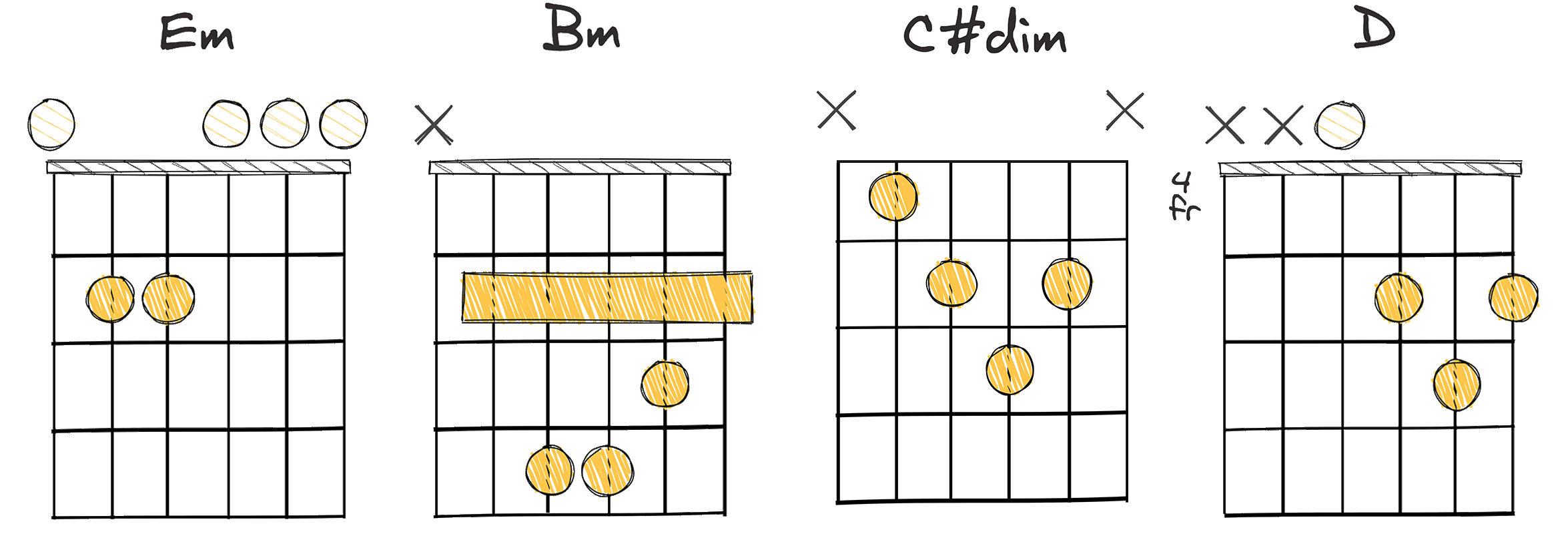
The ii-vi-vii°-I chord progression, also represented as 2-6-7-1, is a staple in many genres of music, particularly within the realm of ambient music.
It draws its roots from traditional jazz, but has been seamlessly incorporated into the compositional structure of ambient pieces due to its atmospheric tendencies.
In fact, it’s this jazz-influence that makes this chord progression somewhat intermediate to play as it requires a strong understanding of theory and the ability to navigate complex changes.
The beauty of the ii-vi-vii°-I progression lies in its versatility and its harmonic structure, which allows it to create a floating, ethereal atmosphere while still maintaining a sense of direction and resolution.
This makes it a favorite for songwriters and composers in the ambient genre.
Supporting this statement, the potency of this chord progression in creating atmospheric music can be attributed to its structure.
The ii chord sets the stage, introducing a touch of tension.
This is immediately followed by the VI chord, which adds an interesting shift in texture and tonality, further pushing the limits of the progression.
The vii° chord is what truly gives it an ambient feel.
It’s often played as a diminished chord in major keys, which carries an airiness and sense of mystery to it while setting up seamlessly for the resolution.
Finally, the I chord brings the progression full circle, resolving the tension and giving listeners a sense of completion.
In the key of D Major, this progression would be Emin – Bmin – C#dim – D, respectively.
Despite its complexity and jazz roots, something noteworthy about this specific progression is its use across many other genres.
This just further cements the fact that it is not just a great tool for ambient music but also a diverse and versatile composition tool for any songwriter or music creator.
For anyone wishing to delve into the world of ambient music creation, understanding and mastering this progression is no doubt crucial.
Achieving this level of proficiency with the ii-vi-vii°-I progression can truly propel a musician’s ability to create intricate, atmospheric and impactful music compositions.
iv-vii-ii-V (4-7-2-5)
A descending, cyclical progression, perfect for crafting dreamy atmospheres.
This iv-vii-ii-V chord progression is popular in ambient music for its unique ability to evoke a calm, atmospheric sound. The subdued tonality and delicate harmonic interactions between these four chords generate a soothing and ethereal vibe, ideal for creating relaxing ambient soundscapes.
- Difficulty: Intermediate
- Example: Bbm – Edim – Gm – C (Key of F Major)
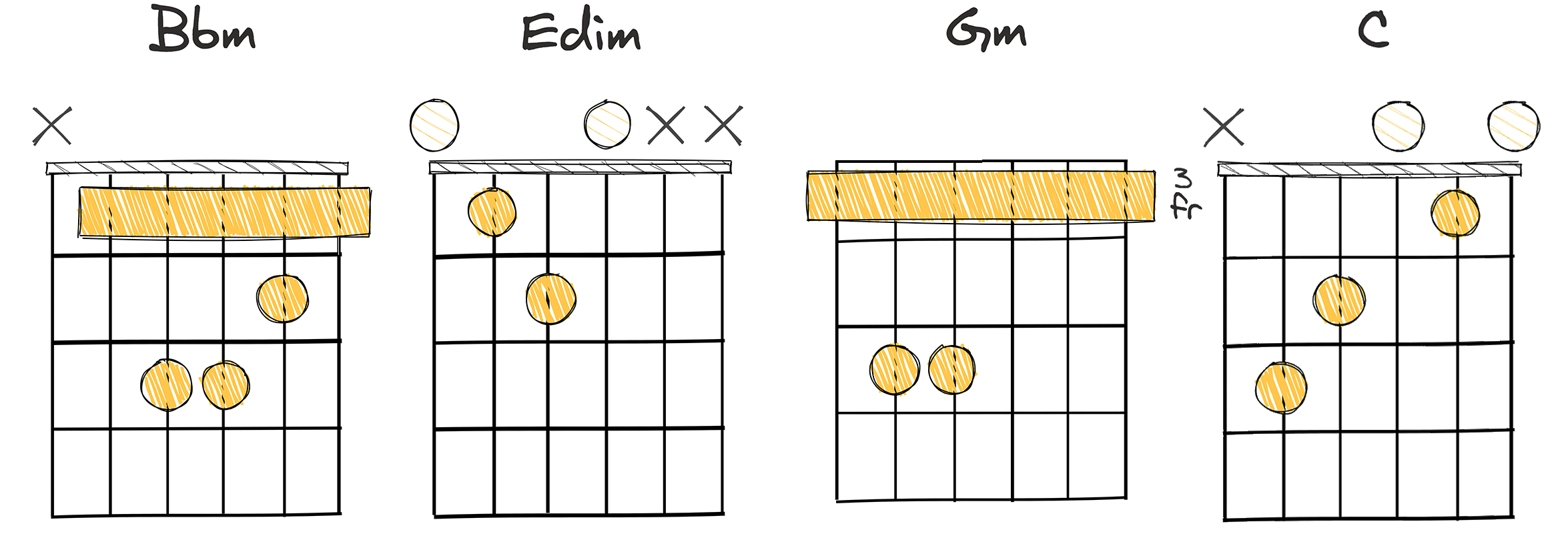
The iv-vii-ii-V or 4-7-2-5 progression is utilized in many ambient and atmospheric songs to create a sense of space and tranquility.
This chord progression follows the pattern of moving you from the subdominant (iv), to the leading tone (vii), to the supertonic (ii), and finally to the dominant (V) in this key, which can produce a powerful, ambient atmosphere.
The origins of this chord progression can be traced back to traditional musical theory, where the dominant-to-tonic resolution has always been a staple.
Interestingly, the progression adds an extra level of tension and resolution by cycling through not just the dominant and tonic, but also the subdominant and leading tone, giving it a more complex feel.
This complexity is commonly experienced in ambient and post-rock genres where these same progressions are often stretched out over longer periods to create sprawling, atmospheric soundscapes.
The quote emphasizes that the nature of these genres allows musicians to explore the depths of these chord progressions at a slower pace, lending to the atmospheric environment.
The chord movement in this progression, from Bbm – Edim – Gm – C (Key of F Major), creates a foundation for the intermediate player to explore different voicings, spacing, and rhythm to create their unique sound.
The chord voicings and spacing are where one can really start to colour the music with their own personal touch and preference.
All the while, the consistency of using this chord progression can offer the impact and fullness listeners often desire from ambient, atmospheric music.
Ultimately, the iv-vii-ii-V or 4-7-2-5 progression offers the opportunity to craft beautiful, ambient melodies that evoke a range of emotions from the listener, truly demonstrating its effectiveness in creating atmospheric music.
Each part of the progression holds its worth and together, they create a beautiful, emotive and fluid series of tones that are exemplary of the genre.
vi-IV-I-V (6-4-1-5)
A soothing, ethereal progression evoking a sense of vast openness.
The vi-IV-I-V progression creates a harmonically rich and atmospheric tone, ideal for shaping ambient and cinematic music. It starts on the sixth chord, creating a melancholic feel, progresses to the fourth providing a soothing relief, moves to the tonic or home chord bringing familiarity and resolve, and ends with the fifth chord which builds anticipation, lending itself to repeat the progression effectively.
- Difficulty: Intermediate
- Example: Am – F – C – G (Key of C major)
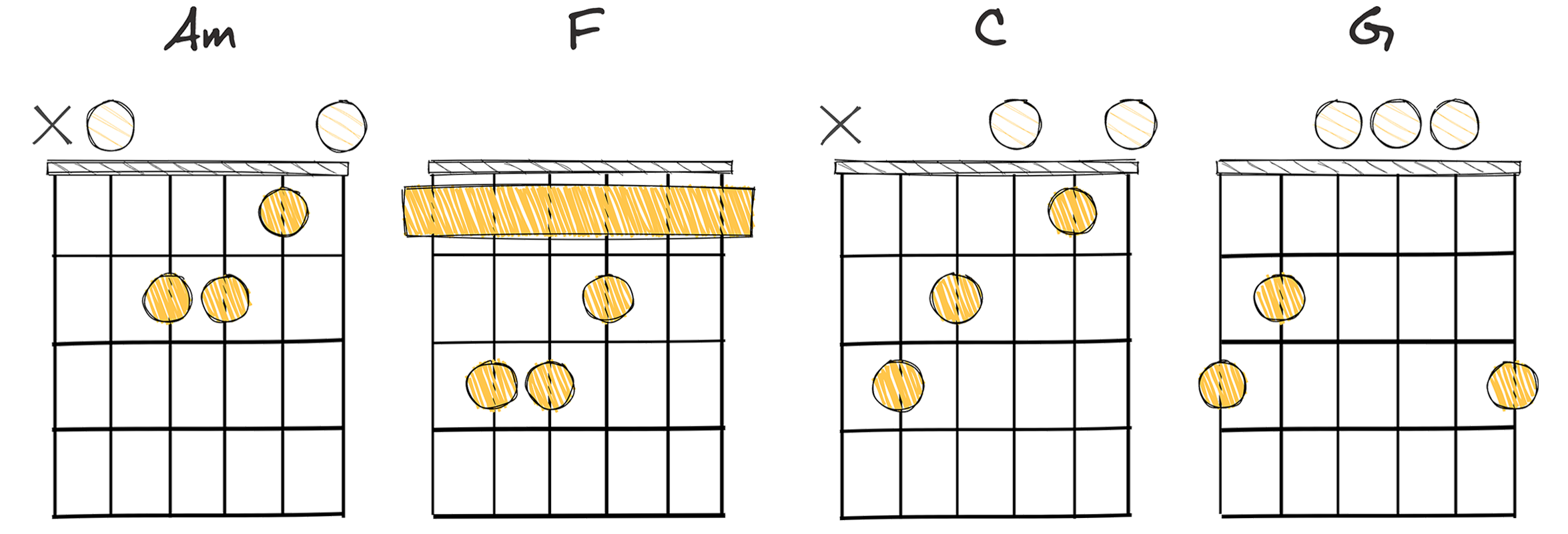
One of the more captivating progressions in the collection is the vi-IV-I-V (6-4-1-5) progression, also referred to as the Am – F – C – G in the key of C major.
This progression commands a place in the intermediate level of chord progressions, and its compelling nature often stems from the effective use of suspended tensions and resolutions.
The choice of starting on the sixth degree (vi) in this sequence brings a haunting, melancholy mood to the composition, which sets the ambience straight off the bat.
Transitioning next to the fourth degree (IV) offers a sense of reprieve and hope, lightening the monotonous tone established at the start.
Upon reaching the first degree (I), a significant resolution point, the music feels complete and contented, bringing an uplifting feel to the soundscape.
This resolution in the progression relieves the tension previously built, bringing a soothing touch to the listeners ears.
It provides a sense of comfort, aligning the emotional journey of the listeners with the chord progression.
Finally, moving into the fifth degree (V) helps to round out the progression, often encouraging a return to the beginning to start the cycle anew.
Such structure provided by the vi-IV-I-V progression is quite cyclic in nature, therefore creating a feeling of continuity and unending flow of music.
Interestingly, the cyclic quality of this progression gives it a timeless character, making it a staple choice in the crafting of ambient, atmospheric music.
This chord progression has a rich history, having been used extensively across a range of musical genres, from rock and pop, to jazz and classical.
At its core, the vi-IV-I-V progression remains a coveted choice for musicians seeking to imbue their compositions with a sense of emotion and atmosphere, making it a favorite in the creation of ambient music genres.
The vi-IV-I-V progression is not only a widely recognized and utilized chord progression within the music industry, but its uncanny knack of creating atmosphere and emotion marks it as a significant contribution to the world of ambient music.
IV-vii°-vi-I (4-7-6-1)
This progression evokes subtle tranquility, wrapping listeners in calming harmonies.
The IV-vii°-vi-I chord progression is a sequence often employed in producing ambient music, characterized by its thoughtful and atmospheric qualities. The progression starts on the fourth degree, progresses to the seventh, then the sixth, and finally resolves back to the tonic, creating a serene and harmonious soundscape that’s ideal for fostering a tranquil musical environment.
- Difficulty: Intermediate
- Example: G – C#dim – Bm – D (Key of D major)
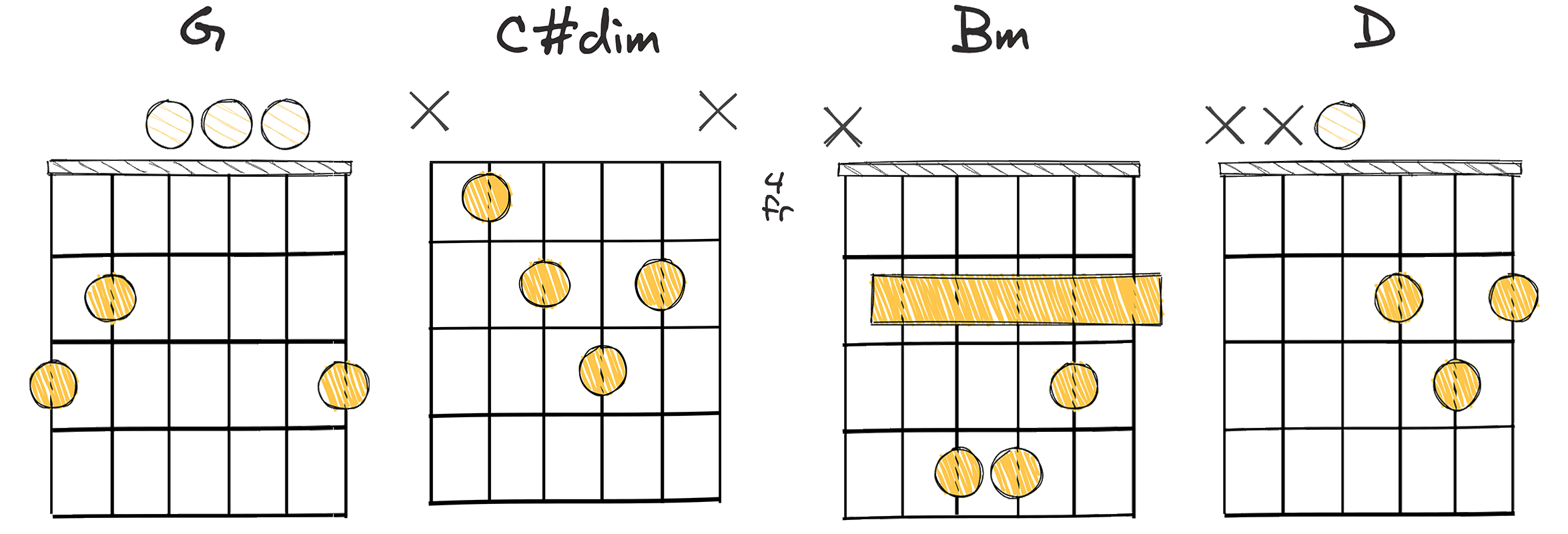
The IV-vii°-vi-I (4-7-6-1) chord progression, or in this case, G – C#dim – Bm – D in the key of D major, is commonly used in the genre of ambient or atmospheric music.
Chord progressions like IV-vii°-vi-I ground the listener, giving a sense of space, calm, and contemplation.
They are widely favored by ambient composers due to their unique combination of harmonic tension and resolution.
The effective use of the IV-vii°-vi-I progression can evoke a wide spectrum of emotions and create a tranquil, expansive audio landscape.
Following this impactful sentiment, it’s important to understand that each individual chord within the IV-vii°-vi-I sequence plays a crucial role in obtaining this effect.
The first chord, IV (G), typically establishes a comforting, predictable base, inviting the listener into the soundscape.
Followed by the vii° (C#dim), a relatively tense chord, this progression adds an element of uncertainty and anticipation into the mix which actually enriches the overall atmosphere.
The third chord, vi (Bm), provides a measure of relief from the tension generated by the proceeding chord, smoothly transitioning into a more peaceful, calmer territory.
Lastly, the I (D), serves as the resolution point, delivering a satisfying conclusion to the cycle while also offering a smooth transition back to the IV (F), if the chord sequence is being looped.
From a historical perspective, the IV-vii°-vi-I progression has deep roots in both classical and popular music.
It’s intermediate level of complexity to play offers the player a good balance between challenge and familiarity.
V-IV-ii-vi (5-4-2-6)
This progression delivers an ethereal, melody-driven ambiance through descending chords.
The V-IV-ii-vi chord progression is characterized by its gentle transitions and tonal ambiguity, making it ideal for creating ambient, atmospheric music. This progression, starting on the dominant 5th, ventures into the subdominant and travels through a minor chord, ensuring a rich, soothing soundscape that creates an immersive auditory experience.
- Difficulty: Intermediate
- Example: D – C – Am – Em (Key of G major)
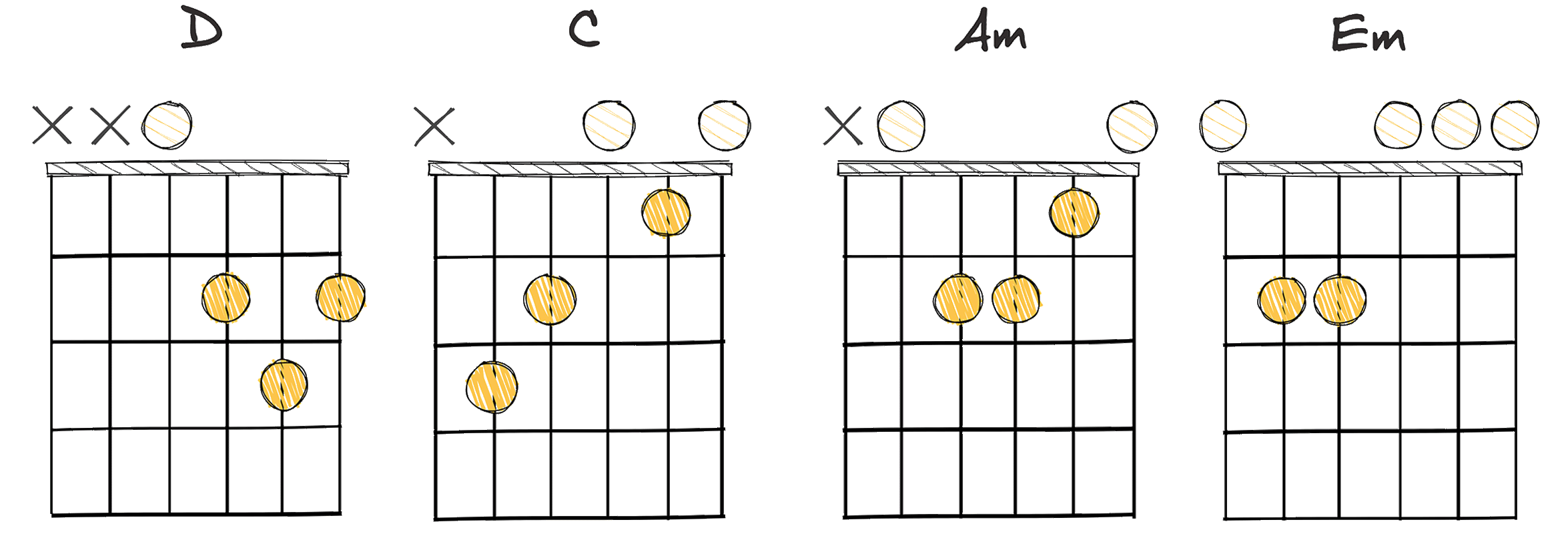
The V-IV-ii-vi chord progression, otherwise known as the 5-4-2-6 progression in ambient music, is a versatile and powerful tool in creating atmospheric sounds.
As an intermediate level progression, it can be seamlessly integrated into various compositions and can significantly enhance the overall mood and tone.
Being a relatively old progression, its history dates back to the classical era, and it has continued to be a favourite of many musicians in the ambient genre.
The charm of the V-IV-ii-vi chord progression lies in its tonal balance, which allows for an immersive listening experience as the chords smoothly transition from one to another.
This chord progression allows for a seamless transition from a dominant to a sub-dominant chord, followed by a pivot into the relative minor key, creating a rich, intoxicating blend of harmonies.
The well-considered transition between chords lends the progression a unique equilibrium.
When played in the key of G major, this progression would follow the order of D – C – Am – Em, where G is the dominant (V), D is the sub-dominant (IV), Am is the Supertonic (ii), and Em is the submediant (vi).
When executed correctly, this progression can evoke deep emotions and drench the listener in a feeling of tranquility and peace – a fundamental characteristic of the ambient genre.
Antiquated though it may be, its use in contemporary music has not diminished, and if anything, this progression has seen a sort of resurgence in the ambient and new-age music scene.
Sound design plays a significant role in the effectiveness of the V-IV-ii-vi progression, with each chord having its distinct identity within the ensemble.
The careful crafting of song dynamics, along with the intelligent use of this progression, can result in ambient pieces that are atmospheric, emotive, and resonate deeply with the listener.
Ultimately, the V-IV-ii-vi chord progression is a dynamic and powerful tool for any ambient musician looking to create an entrancing sonic experience.
It has stood the test of time, passed down through generations, and will likely continue to be a staple in the contemporary ambient music scene.
Its understanding and masterful application can significantly amplify the mood and emotionality of a composition, making it an essential part of any ambient musician’s repertoire.
I-vi-IV-V (1-6-4-5)
An atmospheric journey through familiar yet impactful harmonic landscapes.
This chord progression, I-vi-IV-V, is frequently utilized in the creation of ambient and atmospheric music due to its melodic and emotional resonance. What sets it apart is its ability to create a calming and introspective mood, making it a perfect foundation for pieces aiming for an ethereal or relaxing vibe.
- Difficulty: Easy
- Example: G – Em – C – D (Key of G major)
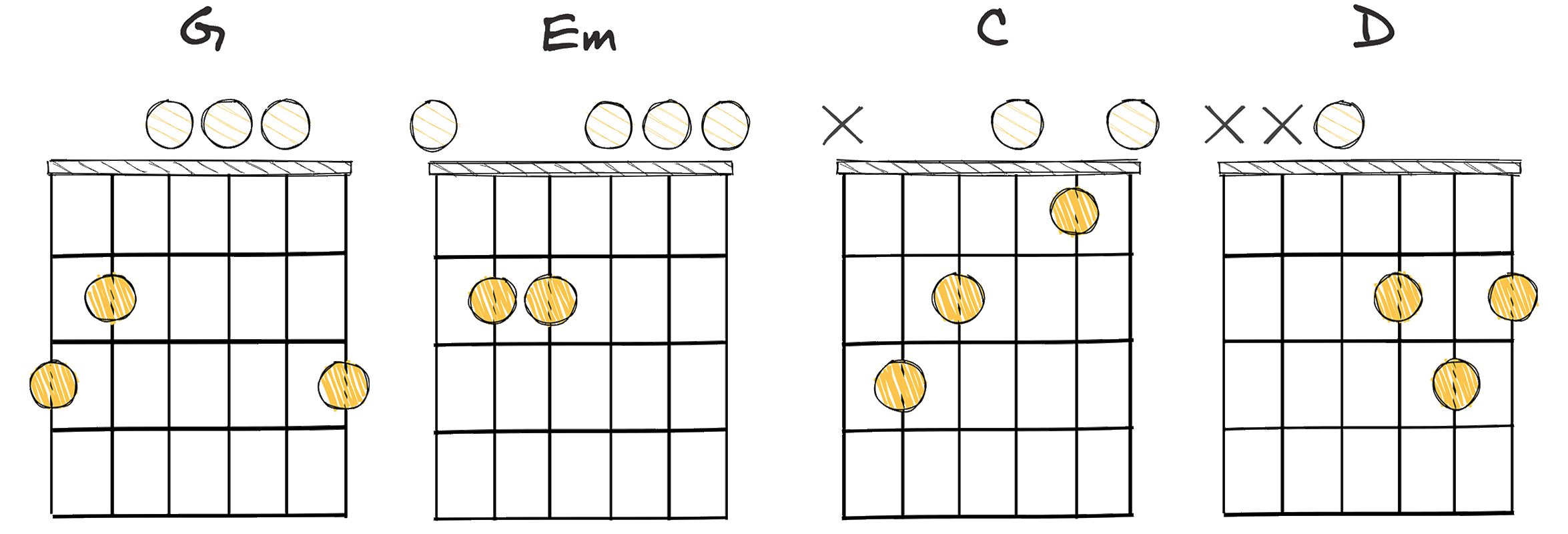
The chord progression identified as I-vi-IV-V (1-6-4-5), when translated into the key of G major, becomes G – Em – C – D.
This progression, simple to play and favored by numerous musicians worldwide, holds a vital place in the history of chord progression
This progression has been vividly observed across different genres, from pop to rock, blues, or country.
It’s richly resonating and universally appealing nature makes it suitable for creating hauntingly beautiful ambient music
In the context of the chord progression’s historical usage, one of the most famous examples would be The Beatles’ “Let It Be”.
The main verses and choruses of this iconic song feature this exact chord progression
This ambient chord progression, with its minor-key nuance synced with major-key brightness, creates an eerily beautiful soundscape that is perfect for capturing a wide range of emotions
As touched upon in the quote, this chord progression benefits from its juxtaposition of major and minor chords.
It introduces an audience to an element of surprise, an unexpected tension that is garnered through its transition from a major to a minor chord
Furthermore, this 1-6-4-5 progression has an interesting musical quality due to harmonic tension and resolution cycle it creates.
This captivating tension-resolution effect contributes significantly to the atmosphere of the music
Aside from its intriguing musical qualities, the 1-6-4-5 progression also rank as an easy progression to play on various instruments, including the guitar, piano, and ukulele.
That’s why it has been a popular choice among beginner musicians
Moreover, the I-vi-IV-V progression is easy to transpose into other keys, further extending its usability and versatility in different musical contexts
These ambient chord progressions are not just limited to single instrument pieces but also extensively used in ensemble works.
A deep dive into orchestral scores would reveal its usage for generating a somber, atmospheric canvas
Even in the contemporary music scenario, this chord progression is an integral part of the music composition toolbox, employed by composers and songwriters to strike a chord with their listeners
In synthesizer-based ambient music, the 1-6-4-5 progression can be used to generate lush, evolving chord textures that form the bedrock of many a drone or dark ambient pieces
Ultimately, the I-vi-IV-V progression is a powerful tool for creating ambient music.
Its inherent simplicity, combined with an intriguing harmonic tension-resolution cycle, offers extensive possibilities for sonic exploration and emotional expression
ii-V-I-IV (2-5-1-4)
“An atmospheric journey of harmony from tension to tranquil resolution.”
The ii-V-I-IV chord progression is a classic sequence often used in various genres of music that can bring a sense of resolution and tranquility to an arrangement. When used in ambient music, it can create profound atmospheric landscapes, taking the listener on a calming and serene auditory journey.
- Difficulty: Intermediate
- Example: Dm – G – C – F (Key of C major)
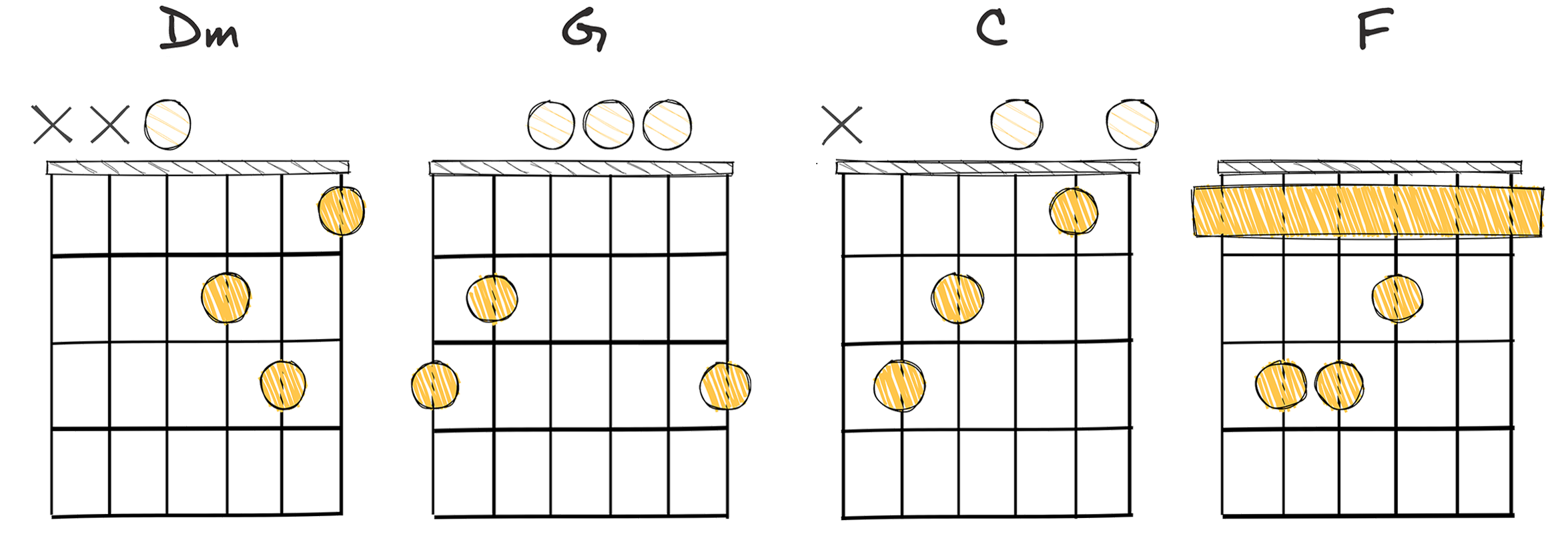
In the world of ambient music production, the ii-V-I-IV chord progression (2-5-1-4) is an essential tool used in crafting a distinct sense of atmosphere.
This chord progression, while firmly grounded in traditional tonal harmony, allows for a wide range of emotional expression and sonic exploration.
Deeply rooted in jazz and pop culture, such a four-chord progression has been used extensively by many composers and artists to create a profound sense of emotion and ambience.
Although it may require an intermediate level of skill to fully master, the rewards for doing so can be substantial in terms of musical depth and richness.
The ii-V-I-IV sequence is a powerful tool for musical exploration, inviting unexpected shifts of mood and tone that can greatly enhance the ambient musical landscape.
Such a statement captures the essence of the potentials this progression provides to musicians.
It beckons varying shifts in the mood and tone whenever it is implemented in a composition.
It’s fascinating to unearth the surprising melodies that can stem from this chord progression, contributing immensely to the overall musical tapestry.
Knowing and understanding these chord sequences can be a graced opportunity for artists to create an enhanced musical experience.
Therefore, studying them can open new avenues in music by creating an ambience oozing with emotion, sentiment, and depth.
This complexity requires understanding the intricacies involved to truly appreciate its essence.
The ii-V-I-IV progression might seem a bit overwhelming at first, but with practice and patience, its potential for creating atmospheric music is infinite.
Nevertheless, no matter the musical map, the emotional impact of the ii-V-I-IV progression resides in how an artist manipulates it.
The possibilities for creating ambient, atmospheric music using this chord progression are endless, making it an invaluable tool for any musician who ventures into ambient composition.
The Bottom Line
Designed to serve as an insightful exploration into the various chord progression combinations, this article presents a comprehensive list of prolific chord progressions ingrained in music creation.
From I-IV-V (1-4-5), the classic blues progression, to more complex structures like ii-V-I-IV (2-5-1-4), the integral elements of jazz harmony, each progression offers a unique blend of tones to stimulate varied emotional responses.
Recognizing and understanding these patterns provide musicians with enriched tools to express their creativity and make their compositions more engaging.
Undeniably, these progressions hold immense value, shedding light on the aesthetic beauty of musical intricacies while paving the way for more diverse and enriched music creation.
In love with guitars, and gear; expert in all things music! Been writing about guitars for about 5 years and counting. Born in the ’90s. Alma Mater: University of Havana. Always curious, trying to understand the world. #TeamFender




